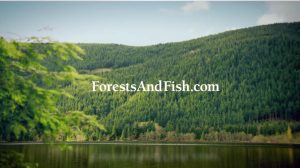WFPA advances policies that keep forests working, mills running, and rural communities strong.
WASHINGTON FOREST PROTECTION ASSOCIATION
Forest Health

Survival and Growth
After seedlings take root, natural selection comes into play, with essential guidance from foresters. Remarkably, more than 85% of planted seedlings thrive in reforested areas. Over the next generation, private landowners invest over $400 per acre to enhance the growth of young trees. It often takes three generations of human foresters, practicing sustainable science-based forestry, to manage just one generation of private forest.
THINNING FOR IMPROVED TREE GROWTH. REDUCES FIRE DANGER
Thinning is the process of selectively removing trees in a forest to reduce density and competition, promoting the growth of higher quality trees. Reforested second-growth forests undergo thinning every 10 to 15 years, eliminating weaker trees to provide more space and light for stronger ones, enhancing overall forest health. The removed trees and branches are utilized in paper and pulp-based products. Scientific research confirms that active forest management, such as thinning, can restore ecosystem health, improve habitat quality, and reduce wildfire risk by reducing excess fuels.
Bipartisan Commitment
Enhancing forest health and minimizing fire risks while supporting rural jobs are bipartisan priorities in Washington. The Washington DNR’s 20-Year Forest Health Strategic Plan outlines how these goals can be achieved.
A Shared Responsibility
Through proper herbicide application, private forest landowners can foster the growth of young trees by controlling competing wild vegetation above and below ground and enriching soils with fertilizers. Strict herbicide use requirements ensure the protection of water and soil quality, as well as the habitat of fish, wildlife, and local communities. The forestry practices of WFPA’s members are the result of extensive science-based research, adaptive management, and collaboration.
Managing Health Threats
Insects, diseases, and excessive animal damage pose threats to healthy, sustainable forests. Foliage and root diseases can spread and harm trees. Insects like bark beetles target stressed trees. Extreme temperatures, drought, and high winds can damage large forest areas or create vulnerability to disease and insects. Excessive animal damage can hinder the growth of new forests. Accurate diagnosis and effective management are crucial to protect forests and ensure their future growth.
Private Forest Landowners Help Develop Forest Health Strategy
Achieving healthy forests is a joint effort between the public and landowners. Private landowners actively participate in the State’s Forest Health Technical Advisory Committee, which engages with the public to address concerns about forest health. Legislation will be developed, following a three-tiered approach:
- Protecting forests from fire, insects, and disease.
- Encouraging voluntary actions by landowners to reduce forest health hazards.
- Implementing state actions requiring landowners to address forest health hazards.
For more information, visit Washington State Wildfires to learn about reducing the risk of catastrophic wildfire.
Learn More About Reducing the Risk of Catastrophic Wildfire
In Washington, nearly 175,000 acres burned in 2022, however, the average number of acres burned in wildfires between 2014-2021 was 607,813 acres each year, emitting more than 8.6 million metric tons of CO2e each year. This is equivalent to emissions from driving 1.9 million cars each year, that’s 64% of the 2.98 million registered cars in Washington. (Source: Forest Health Treatment Framework 2014‐2021 (pg 147) and Washington State Greenhouse Gas Emissions and EPA’s Greenhouse Gas Equivalencies Calculator)

A Balanced Solution with Managed Working Forests
Managed working forests provide a vital solution to this pressing issue. By maintaining healthy, growing forests and simultaneously producing valuable wood products, we can effectively lock away carbon and prevent its release into the atmosphere.
The Carbon Sequestration Advantage
Consider this: on average, each acre of managed Forest Industry lands sequesters an impressive 4.9 tons of carbon dioxide annually. Over half of this stored carbon is transferred into the harvested wood products. This is a stark contrast to formerly managed National Forests, where only 2.9 tons of CO2 are sequestered. In these forests, a staggering 70% of annual growth is lost due to dead and dying trees, which emit carbon. Worse yet, in the event of a forest fire, all the carbon stored in these trees is released back into the atmosphere in one catastrophic event.
Managed working forests represent a practical and sustainable solution to mitigate climate change. By nurturing our forests and responsibly utilizing their resources, we can continue towards the path of carbon neutrality while benefiting from the wood products they provide.
Source: Ganguly, I., L. Droog, F. Pierobon. 2023. Global Warming Mitigating Role of Forests in Washington State, by Land Ownership Type.


